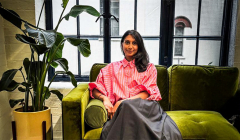
Why the creative industry needs to own its choices
When Hanisha Kotecha pushed for representation behind the lens she had a complaint filed against her, an experience she shares to spark change.

Paul Greenwood explores how changing times have repositioned influencers creating both challenges and opportunities

The relationship between brands and influencers has evolved significantly in recent years. In 2023, we’ve arguably seen some of the biggest shifts to date. The impact of technology along with platform changes and more has resulted in the nature of influence undergoing a profound transformation.
At the beginning of the year, we saw the cost of living crisis taking over both people’s headspace and media headlines. Economic downturns have long been catalysts for cultural shifts, and this was true when looking at the current crisis’s impact on influencer behaviour. The ‘de-influencer’ trend emerged and has now become ingrained into creator behaviours, with the role of influencers evolving to help users find affordable alternatives. Creators have become more empathic and more aware of their tone in 2023, as many transitioned from aspirational to relatable. Going into 2024, we expect to see creators continue to flex what they know, rather than just what they have. Influencers have learned from the cost of living crisis just how powerful their knowledge can be.
It’s not just the content that influencers are producing that’s shifted this year, the way they work has changed too. In our recent Future of Influence report, we identified a behaviour we call ‘Collective Influence’ - creators are banding together in groups, rather than working as individual talent. Driven by creator burnout due to the pressure to be ‘always on’ we’re seeing influencers banding together in collectives to share the burden of the creative process, and strengthen their impact in a crowded space. Yancey Strickler, Co-Founder of Kickstarter and Metalabel described it neatly as “creativity in multiplayer mode”. This is playing out in a lot of ways; metalabels, media collectives; collaborative substacks or DAOs like RADAR. It means that influencers have an even greater potential to impact culture - this coalescence creates scale and impact.
Creators who would once have been hired as a mouthpiece for a brand are now setting up their own companies, and taking their trusting, loyal audience of followers with them.
Paul Greenwood, Head of Research & Insight, We Are Social
This increased sense of power and control amongst creators is also changing the way they monetise their offering, by redefining the terms of patronage to get their rightful piece of the pie. The emergence of creator brands has had a profound impact on culture - Logan Paul and KSI’s Prime energy drink defined influencer popularity in 2023. Creators who would once have been hired as a mouthpiece for a brand are now setting up their own companies, and taking their trusting, loyal audience of followers with them. This clearly has a knock on effect for brands - with creators less reliant on external partnerships, brands will need to work harder to find those who have a really authentic and genuine connection with them and their product.
In 2023, it’s impossible to write a piece focused on current cultural shifts and future possibilities without highlighting the impact of AI. Powered by generative AI, everyday people now wield the ability to modify or generate any type of media they can imagine, and enact prompt influence - experts estimate that as much as 90% of online content may be synthetically generated by 2026. While social media users might not yet spot the immediate impact of this on the content product by the influencers they follow day to day, innovative individuals are leading the charge towards new manifestations of influence by harnessing new technologies.
We’re seeing some people leveraging AI to extend themselves beyond their human capabilities. Korean music giant Hybe utilised AI voice technology to launch MIDNATT, which serves as an alter ego of their existing artist, Lee Hyun. Canadian artist Grimes has allowed fans to utilise her voice without penalty, and share in the upside. AI has also become a means to resurrect or prolong influence -for example, The Beatles enlisting the help of AI technology to extract the late John Lennon’s voice from an old demo tape to use on a new record. We’re still in the early days of this technology, but it’s worth brands considering the implications now in relation to how they can work with the more forward thinking talent in interesting and experimental ways.
While all this might seem a lot to take in, when it comes to working with creators, there’s still one overarching rule that’s always essential to follow - authenticity is key. Working with partners who are a true reflection and extension of your brand, cocreating to allow the influencer’s personality to shine through. The relationship good creators have with their audience is sacred and when working with talent, a brand is encroaching on this shared space. Being respectful of this is the foundation of a great partnership.
Paul leads as the global head of research & insight at We Are Social, spearheading the Insights and Effectiveness teams. He plays a pivotal role in driving the agency's cultural insights offering, empowering brands to cultivate a nuanced understanding of digital (sub-)cultures, and actively contributes to the agency's global thought leadership initiatives, positioning We Are Social as a trusted authority in the industry. He’s also responsible for the development of robust measurement standards, proving the value of social content and campaigns for clients. With a keen focus on fostering consistency in reporting and insight generation across diverse markets, Paul oversees the agency's global measurement frameworks, effectively disseminating knowledge, sharing best practices, and tracking the performance of social strategies against pre-established benchmarks.
Looks like you need to create a Creativebrief account to perform this action.
Create account Sign inLooks like you need to create a Creativebrief account to perform this action.
Create account Sign in